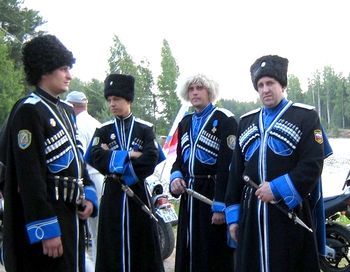
Terek Cossacks Experience Internal Challenges and Government’s Distrust
Publication: Eurasia Daily Monitor Volume: 12 Issue: 30
By:

The Terek Cossack Military is facing a crisis as the Cossacks and the Russian authorities cannot find a candidate for the leadership position in the organization that would satisfy both sides. The initial plan to hold elections for the new ataman (Cossack chieftain) in February fell through, and the next possible date for elections was moved to April. The Terek Cossacks reportedly “proposed manifestly impassable candidates,” while the authorities also abstained from forcing the Cossacks to elect a candidate without their approval (Kavpolit.com, February 12).
A Terek Cossack electoral rally was planned for Vladikavkaz, North Ossetia, on February 21. Three out of the four candidates for the position of ataman came from the Stavropol Cossacks and one from the Kizlyar Cossacks. After the candidates are elected by the Terek Cossacks, their paperwork is transferred to the Council for Cossack Affairs under the Russian president and the administration of the North Caucasus Federal District. After official approval, the candidates proceed to the third stage, at which one of them is elected ataman of the Terek Cossack Military (Terkv.ru, accessed February 18).
The Terek Cossack Military is a quasi-state organization because it is part of what is often referred to as the “registered Cossacks.” The “registered Cossacks” are officially on the government payroll and carry out the government’s orders, including fighting in the many local wars in post-Soviet countries. The so-called “free Cossacks” have less direct affiliation with the state, which allows them to raise Cossack issues that the government in Moscow or regional governments do not approve of, such as the rehabilitation of the Cossacks. Soon after the 1917 revolution, the Soviet government unleashed a violent campaign against the Cossacks in the North Caucasus and elsewhere in southern Russia because of the Cossacks’ staunch support for the Tsarist regime. In contemporary Russia, the Cossacks were rehabilitated, but they did not receive material compensation in an organized, coherent manner. Moreover, there is still a debate over whether the Cossacks are a separate ethnic group or just ethnic Russians with cultural peculiarities and special social functions.
The issue of Cossack identity is especially sensitive today. It is well known that many of the Terek Cossacks and their neighbors to the west, the Kuban Cossacks, are the ancestors of ethnic Ukrainians. Broken Ukrainian is considered to be the Cossack native language, which is also called “Mova.” So, recognizing the Cossacks as a separate nation would contradict the entire Russian official paradigm of the “united Russian nation” that supposedly encompasses not only ethnic Russians, but also ethnic Ukrainians and ethnic Belarusians (Kremlin.ru, July 27, 2013). In this grand vision of the Russian World (Russky Mir), the Cossacks cannot be considered anything more than Moscow’s henchmen who take government orders. The problem with this approach, however, appears to be that the Cossacks also cease to be a coherent force in society and either sabotage the government’s orders or cannot implement them because of their lack of identity.
One of the candidates for ataman of the Terek Cossack Military, Nikolai Spirin, the Cossack leader from Kizlyar, Dagestan, reportedly resigned shortly after he was nominated to run in the elections. Spirin was implicated in falsifying the activities of the Cossacks in Dagestan by presenting a large Cossack force on paper while having only about 50 people on hand. A quota for 100 young Cossacks to enter Dagestani colleges and universities was not used and a large republican government program to support the Cossacks in the republic was not implemented. Cossacks in Chechnya are largely “decorative” communities, given that Cossack villages have more recently lost their Cossack population and essentially became Chechen villages. The few Cossacks who remain in Chechnya tend to increasingly leave the republic for good, despite considerable efforts by the republican government to retain the Cossack population. Even the heartland of the Terek Cossack Military, the Stavropol region, is experiencing its own issues. Corruption and other criminal scandals have affected the Cossacks in Stavropol (Kavpolit.com, February 12). The Cossack leadership there also was implicated in the egregious murder of a man in a hospital in the city of Mineralnye Vody in September 2014 (Aif.ru, September 30, 2014).
The recent scandals involving Cossack organizations prompted greater scrutiny of Terek Cossack activities by the Russian government. In addition, against the backdrop of falling revenues, the government may be planning on cutting back on its support for the Cossacks. The registered Cossacks say they themselves do not fully understand what the government wants from them. While Moscow put the Cossacks to use at the time of wars with Chechnya and in regional conflicts in the post-Soviet countries, the Cossacks seem to be currently out of place, at least in some regions. Moscow has raised the next generation of regional strongmen, such as Chechen leader Ramzan Kadyrov, who are not in the position to share power with the Cossacks. At the same time, Moscow is not willing to strengthen the Cossack identity by recognizing them as a separate ethnic group. Given the current de-facto Russian-Ukrainian war, such recognition is especially hazardous to Moscow’s plans, because the Cossack ethnicity in the North Caucasus would have a striking resemblance to ethnic Ukrainians.




